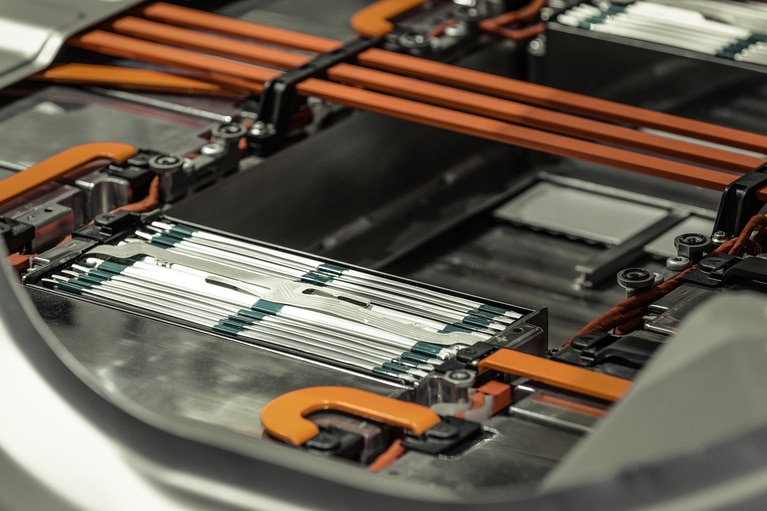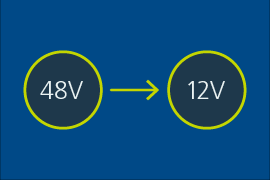
The future of long-haul trucking is accelerating autonomously on a freeway near you
Kodiak autonomous technology revolutionizes long-haul trucking. Learn more about Vicor power modules that drive mission critical ‘seeing’ sensors
Modular power designs are gaining more traction in the race to automotive electrification. In a field where a premium is placed on space and weight, Vicor high density power modules are a perfect solution.
By Patrick Wadden, Global Vice President of Automotive Business Development
What you’ll learn:
Automotive technology roadmaps are notoriously difficult to predict given the automotive industry’s lengthy and involved design cycles. Unlike other purchases, car ownership is an expensive, long-term commitment that reinforces a methodical, rigid mindset when it comes to the industry’s approach to risk taking and bleeding-edge innovation.
That said, we see two electrification trends taking place over the next three to five years: Increasing usage of modular power and the inexorable adoption of 48V battery technology. Both are driven by OEMs racing to electrify their fleets.
Let’s examine each trend. Modular designs can reduce development complexity, simplify supply-chain management and inventory carrying costs, and accelerate time to revenue. If your automotive entertainment system fails, for example, the dealership doesn’t send for a radio repairman. They dismantle the center stack and replace the entire head-end unit.
With the biggest car companies releasing as many as 15 different models over a given three-year span, the transition to interchangeable designs is here to stay.
Power and powertrain engineers have begun lifting a page from this playbook as a means of repurposing the same core design across multiple vehicle platforms with different features and price points. This is becoming more apparent as the proportion of the vehicle served by electronic systems rises from roughly 34% today to better than 50% in the next few years.
High-density power modules, for example, help reduce packaging space and weight and therefore can enhance range. And that shift will be driven by yet more modular technologies, among them steer-by-wire and brake-by-wire, which run off the electrical system, not the alternator. These replace mechanical components with a battery, wired control box, and an actuator.
Figure 1: Vicor power modules deliver power density, high-efficiency, and flexibility to support and scale next-generation xEV power delivery networks.
It helps explain why the Big Three U.S. car makers pledged $100 billion last year on new vehicle platforms, even as they let go of thousands of mechanical engineers and continue desperately hunting for electrical engineers and electrification experts to take their place.
The auto industry’s love affair with the ubiquitous 12V battery shows no signs of flaming out. Many car and truck owners, for instance, have unwittingly benefited this past winter from the brute cold-crank performance of a 12V lead-acid battery. Its chemistry ensures the vehicle will turn over in frigid conditions in a way that 48V lithium-ion batteries cannot. Even so, the rationale for augmenting certain applications with a 48V replacement continues to gain ground.
In recent years, we’ve seen 48V battery adoption beginning to climb, particularly in smaller auxiliary components such as fans, blowers, and chillers. Or take active suspension, a sophisticated piece of electronic circuitry that compensates for weight shift in a vehicle.
The duty cycle on these systems is extremely low when you’re driving at 60mph on a highway, but when you take an exit ramp, the weight shifts and the active suspension can source enough current to drive power levels to a 4 or 5kW peak. Doing that on a 12V battery requires an enormous slug of current, plus the attendant wiring and harnessing. The same holds true for water pumps, where a 12V supply may require as much as nine meters of cable due to factors such as stray field immunity, seepage, clearance, and electromagnetic interference.
This tilts many new and emerging car subsystems in favor of 48-V batteries, whose 23 grams of cable weighs as little as 10% that of a 12V alternative. The bus that moves 48V throughout the vehicle can be achieved with thinner, lighter wire harnesses and cabling, reducing weight and enhancing range.

Figure 2: Using the Vicor bidirectional NBM and BCM, designers can convert high-voltage power efficiently between 800, 48, and 12V.
OEMs are now focused on reducing the weight of the wire harness in a car, which can exceed 150 pounds, and could be reduced significantly just by swapping to lighter 48V cable. That said, the economics and sheer level of investment required to retool the factory floor from 12 to 48V remains daunting for many car manufacturers, Tier 1 suppliers, and component makers, which have built their entire power infrastructure around an older technology that they continue to cost-reduce.
Nevertheless, better efficiency and reduction of power losses makes an undeniable case for moving to power modules and bussing at 48V. The 12V status quo will soon have company, and those automotive manufacturers who refuse to respond will pay a heavy price somewhere down the road.
This article was originally published by Electronic Design.
Patrick Wadden joined Vicor in 2018 to head up the automotive Business Unit and to drive a new end market segment for Vicor. His experience in the semiconductor industry was spread across automotive, industrial, consumer and aerospace industries with a concentration in power electronics. Patrick previously held leadership roles in sales, marketing, product line and business unit management at Intersil, Altera, ADI and Integrated Device Technology. Patrick holds a BSBA in Management at Northeastern University and lives in NH with his wife and children.
Patrick Wadden, Global Vice President of Automotive Business Development
Automotive solutions: Converting the high‑voltage xEV battery to 48V or 12V
Podcast: The future of long-haul trucking is accelerating autonomously on a freeway near you
Article: Modular approach solves 48V power architecture electrification challenges
Automotive products: The smallest, lightest power modules
The future of long-haul trucking is accelerating autonomously on a freeway near you
Kodiak autonomous technology revolutionizes long-haul trucking. Learn more about Vicor power modules that drive mission critical ‘seeing’ sensors
Vicor offers solutions for maximizing vehicle weight reduction and 48V zonal architectures
Solving automotive electrification challenges with the highest efficiency and highest power density power modules
High tech shortcut to 48 volts
Greg Green from Vicor expounds on the benefits of using power modules in a 48V zonal architecture to John McElroy of Autoline TV
The importance of advanced power electronics in next-generation EVs
Greg Green, Vicor's Director of Automotive Marketing, shares why more power-efficient systems are essential in the design of tomorrow’s electric vehicles








